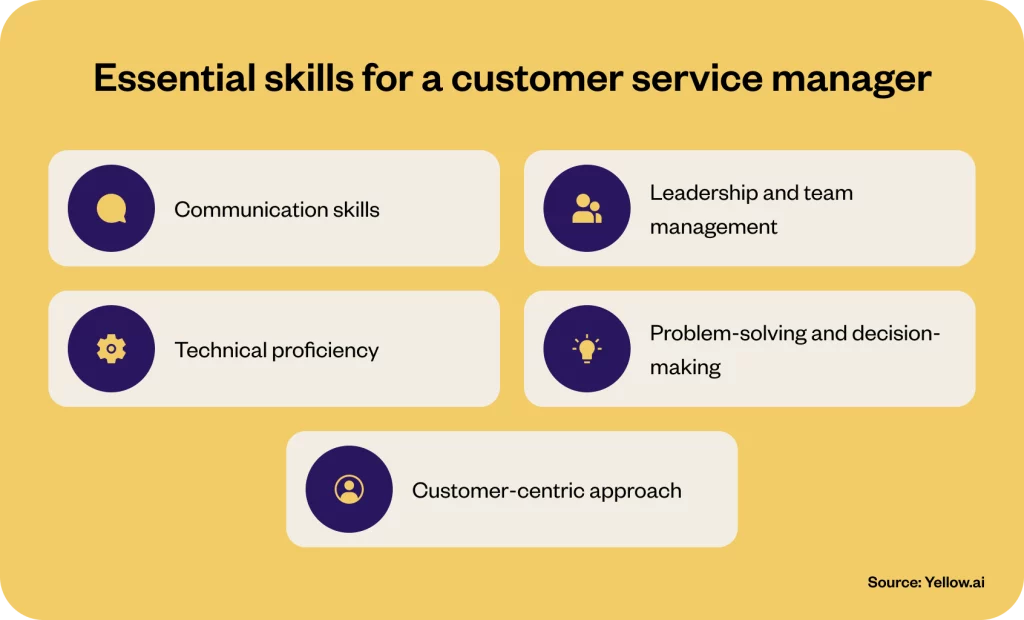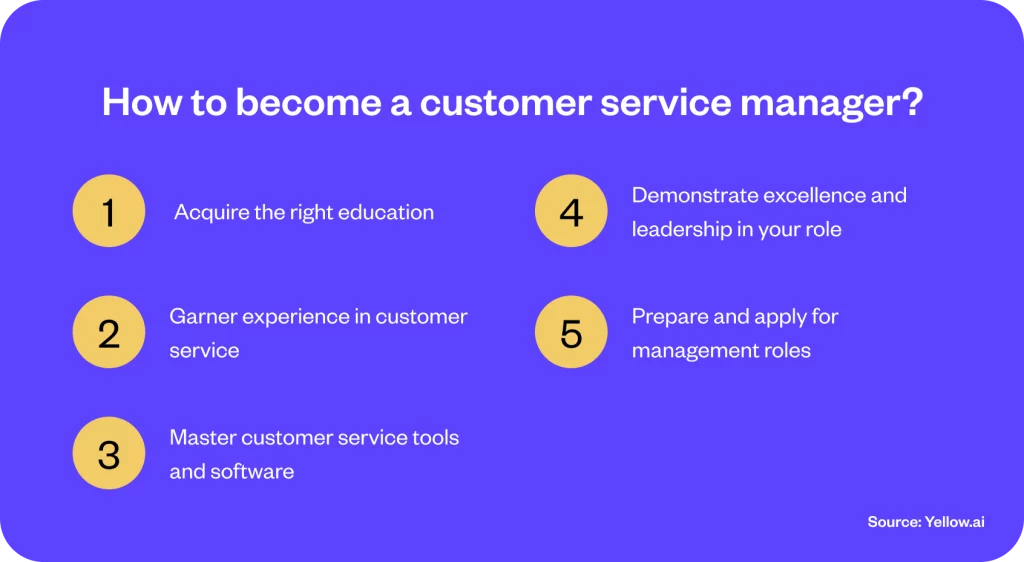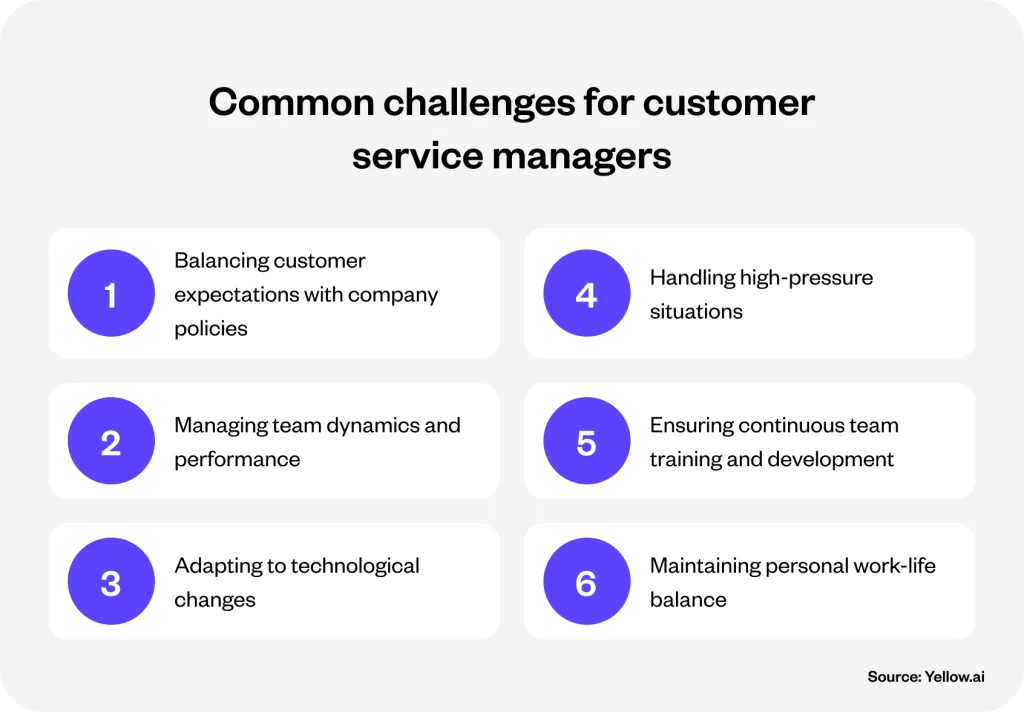Executive summary
This blog demystifies the role of a customer service manager, covering the essential responsibilities, skills, and pathways to becoming one. It aims to equip aspiring managers with insights into the daily intricacies of the position, from coordinating customer service efforts to mastering interpersonal skills. Discover the impact of AI in streamlining customer service processes and enhancing the manager’s toolkit for better efficiency and customer satisfaction.
Stepping into the world of customer service management is like becoming an orchestra conductor, where every note played is crucial to the harmony of customer satisfaction. This role is way more than just overseeing operations. It is also about nurturing a team that consistently delivers service excellence. In businesses where customer interactions are paramount, a customer service manager stands as the cornerstone, ensuring that every customer journey is smooth and commendable.
In the subsequent sections, we’ll unfold the narrative of what it truly means to be a customer service manager, the blend of analytical prowess and soft skills required, and how these professionals adapt to the evolving dynamics of customer needs. While AI and technology play a supporting role in enriching the customer service landscape, the essence remains focused on the human element. It showcases how customer service managers can leverage these tools to enhance their effectiveness without losing the personal touch that defines exceptional service.
What is a customer service manager?
A customer service manager is the heartbeat of a company’s service team. They ensure customers end their interaction feeling heard and helped. Think of them as the ship’s captain, steering through stormy seas to bring everyone safely to shore. Simply put, they manage the folks who answer your calls and emails, ensuring you get the help you need.
Their job matters a lot for businesses because they keep customers happy and loyal. A good manager turns a bad customer day around, making sure one hiccup doesn’t send a customer running to competitors. They’re the unsung heroes in the background, making sure the service team is happy, trained, and ready to solve your problems.
In the business world, having a skilled customer service manager can be the difference between a customer who stays for life and one who leaves after a single bad experience. They blend people skills with savvy problem-solving to keep both the team and customers in sync.
Duties and responsibilities of a customer service manager
The customer service manager’s role extends far beyond just overseeing operations. Their mission is to harmonize customer needs with business goals, creating an environment where service excellence prevails.

Supervising the team
At the heart of their duties is supervising the customer service team. It involves more than just delegation; it’s about nurturing a culture of growth, learning, and respect. By coaching and motivating the team, they establish a workspace where every member feels valued and driven to excel. This supportive atmosphere is crucial for empowering employees to deliver top-tier service, ensuring they have the confidence and skills to handle customer interactions with finesse and empathy.
The impact of effective team supervision is profound. It leads to a more engaged, proficient team that’s ready to tackle challenges and contribute to the company’s success. For example, a manager who successfully coaches a team member through a complex customer issue resolves the immediate problem and also strengthens the team’s capability to handle similar situations in the future.
Customer interactions and satisfaction
Another core responsibility is directly handling customer inquiries and ensuring their team does the same with both accuracy and speed across all communication channels. This direct engagement with customers is vital for maintaining the quality of service and for modeling effective problem-solving behaviors for their team.
Focusing on customer satisfaction is about pinpointing and addressing the pain points in the customer journey. This task requires continuous evaluation and adaptation of policies and procedures to meet evolving customer expectations. For instance, a manager might implement a new feedback system to capture customer sentiment better. It leads to strategic changes that enhance overall satisfaction and loyalty.
Policy development and team building
Developing policies and procedures forms the backbone of the customer service strategy. These guidelines help the team navigate customer interactions, ensuring consistency and quality in service delivery. The manager must balance customer needs with organizational objectives, updating these guidelines as both evolve.
Hiring and training are also pivotal. The manager’s ability to recruit and nurture talent directly influences the team’s performance and the quality of customer service. Effective training programs tailored to both new hires and seasoned team members are essential for equipping staff with the necessary skills and knowledge.
For example, introducing a comprehensive onboarding program for new employees can dramatically improve their understanding of company products and customer handling techniques, leading to better service outcomes.
Goal setting and continuous learning
Setting clear goals and regularly reporting on progress ensures the team remains aligned with the company’s customer service objectives. By monitoring key metrics, the manager can gauge performance and guide the team towards continuous improvement.
Continuous learning is imperative in a rapidly changing customer service landscape. Staying updated with the latest trends, technologies, and best practices allows the manager to keep the team’s approach fresh and compelling. For instance, integrating new communication technologies might streamline customer interactions, enhancing satisfaction and efficiency.
What are the qualifications and skills needed to be a customer service manager?
Embarking on a journey to become a customer service manager involves more than just a desire to lead. It requires a specific set of qualifications and skills that are essential for the role. Understanding these prerequisites helps aspirants gauge what they need to work on to fit this pivotal position.
Educational and experience requirements
Typically, a bachelor’s degree in business administration, communications, or a related field is a foundational requirement. However, the educational aspect is often complemented by substantial experience. This experience, usually spanning at least five years, should be in customer service or related roles where direct interaction with customers and team leadership were core responsibilities. Experience in retail, hospitality, or other service-oriented sectors can also be valuable, providing a practical understanding of customer interactions and service strategies.
Essential skills for a customer service manager

Communication skills: Effective communication is the linchpin of a customer service manager’s role. They need to articulate ideas clearly and listen attentively, ensuring messages are understood across all levels of the team. This skill is crucial in resolving conflicts, explaining complex procedures, and maintaining a transparent dialogue with both customers and team members.
Leadership and team management: A customer service manager must inspire and guide their team toward achieving common goals. It includes setting clear expectations, providing constructive feedback, and fostering a supportive environment that encourages growth and learning. Leadership also involves recognizing and cultivating the strengths of each team member and aligning them with the team’s objectives.
Technical proficiency: In today’s digital age, a customer service manager should be adept with various software tools that facilitate customer management, such as CRM platforms, contact center software, and data analysis tools. Familiarity with these technologies helps in efficiently managing customer interactions and deriving insights to improve service strategies.
Problem-solving and decision-making: The ability to quickly assess situations, identify solutions, and make informed decisions is crucial. A customer service manager often faces complex challenges that require a balance of creativity, analytical thinking, and pragmatic decision-making to resolve effectively.
Customer-centric approach: It is vital to have a deep understanding of customer needs and the ability to empathize with them. This approach helps in designing strategies that enhance customer satisfaction and loyalty, ultimately contributing to the business’s success.
How to become a customer service manager?
The path to becoming a customer service manager involves strategic steps and a commitment to personal and professional growth. Here’s how to navigate the path toward this leadership role:

1. Acquire the right education
While experience in the field is invaluable, formal education lays the foundation. A bachelor’s degree in business administration, communication, or a related field is typically required. These programs provide a comprehensive understanding of business operations, customer relationship management, and effective communication skills, which are crucial for a managerial role.
2. Garner experience in customer service
Experience as a customer service representative offers a ground-level understanding of the daily challenges and operations within the department. This experience is vital, as it equips you with the empathy and insight necessary to manage a team effectively. It’s about understanding the customer’s perspective and the intricacies of service delivery, which are essential for making informed decisions as a manager.
3. Master customer service tools and software
Technological proficiency is a must in today’s customer service landscape. Familiarize yourself with the latest customer service software and tools, as these will be integral in managing processes, analyzing customer data, and enhancing overall service efficiency. Training on these platforms can often be self-directed through online courses or workshops, enabling you to stay ahead in the tech-driven aspect of customer service management.
4. Demonstrate excellence and leadership in your role
To ascend to a managerial position, you must exhibit leadership qualities and the ability to surpass set goals. Document your achievements, customer feedback, and any instances where you’ve gone above and beyond in your role. This track record of success becomes crucial evidence of your capability to lead, showing potential employers or your current management team that you are ready for the next step.
5. Prepare and apply for management roles
With the right blend of education, experience, and a proven track record, the next step is to prepare your resume, highlighting your journey and readiness for a managerial role. Tailor your applications to align with your interests and strengths within the customer service domain. Each industry offers unique challenges and learning opportunities, so choose one that resonates with your passion and career aspirations.
Common challenges for customer service managers
The role of a customer service manager comes with its set of challenges, each testing the resilience, adaptability, and strategic thinking of the individual. Here’s an in-depth look at some common hurdles they face and how understanding these can help businesses and aspiring managers prepare effectively:

1. Balancing customer expectations with company policies
Managers often find themselves walking the tightrope between satisfying customer demands and adhering to company policies. This balancing act requires diplomatic negotiation skills to ensure customer satisfaction without compromising the company’s operational limits. For example, when a customer insists on a refund outside the return policy period, a manager needs to negotiate a solution that maintains customer loyalty while respecting company rules.
2. Managing team dynamics and performance
A significant part of a customer service manager’s role involves fostering a positive work environment and overseeing team performance. Challenges arise in harmonizing diverse personalities, motivating team members, and addressing performance issues. Managers must cultivate a supportive atmosphere where feedback is constructive and achievements are recognized, ensuring the team remains motivated and productive.
3. Adapting to technological changes
With the rapid evolution of customer service technologies, managers must continuously learn and adapt to new systems and processes. This constant change can be daunting, as it requires staying updated with the latest trends and training the team accordingly. For instance, integrating a new customer relationship management (CRM) system into daily operations involves not only technical learning but also ensuring the team is proficient in using the new tool effectively.
4. Handling high-pressure situations
Customer service managers often deal with high-stress situations, including escalated customer complaints, which test their problem-solving and emotional resilience. Successfully managing these scenarios involves staying calm under pressure, making quick yet informed decisions, and communicating effectively with both customers and team members to resolve conflicts.
5. Ensuring continuous team training and development
Ongoing training and development are crucial in maintaining a high-performing customer service team. Managers face the challenge of identifying training needs, developing programs, and measuring their effectiveness. For example, introducing a new service protocol requires comprehensive training sessions, followed by monitoring and feedback to ensure the team’s smooth transition and competency in the new procedure.
6. Maintaining personal work-life balance
Finally, the demanding nature of the role can impact a manager’s work-life balance. Ensuring personal well-being while managing a high-responsibility job requires effective time management, delegation, and the ability to disconnect and recharge outside of work hours.
How can Yellow.ai help automate your customer service process?
Customer service is the frontline of business success, Yellow.ai steps in as a game-changer, offering customer service automation tools like its no-code chatbot builder. This powerful feature enables customer service managers to design, deploy, and manage chatbots that handle routine queries, freeing up human agents to tackle more complex issues. Let’s dive into how Yellow.ai sets itself apart:
- No-code chatbot builder: Quickly create and customize chatbots without needing extensive coding knowledge, streamlining the response process and boosting efficiency.
- Omnichannel integration: Connect seamlessly across email, chat, social media, and more, ensuring a unified customer experience.
- Real-time analytics and insights: Access detailed reports and analytics to understand customer interactions and improve service strategies.
- Personalized customer journeys: Tailor interactions to individual customer needs, enhancing satisfaction and loyalty.
- Automated workflows: Streamline processes and reduce manual efforts, allowing managers to focus on strategic initiatives.
Discover how Yellow.ai can revolutionize your customer service by booking a demo today.
The final thoughts
The blend of human insight and technological prowess paves the way for exceptional customer service experiences. The role of a customer service manager, while challenging, is immensely rewarding, especially when augmented by the right tools. Yellow.ai embodies this synergy, offering innovative solutions that empower managers and their teams to deliver service excellence.
Summing up, it’s clear that the journey of a customer service manager is one of constant evolution and adaptation. With the support of platforms like Yellow.ai, these professionals can transcend traditional boundaries, crafting customer experiences that are not just satisfactory but truly memorable.
Frequently asked questions (FAQs)
What are the 5 qualities of a customer service manager?
Essential attributes of a customer service manager encompass decisive leadership, superior communication proficiency, adeptness in resolving issues, a deep sense of empathy for customers and team members, and the capacity to adapt to evolving circumstances. These traits are fundamental in steering the customer service domain, fostering team unity, and enhancing client contentment.
What are the soft skills required for a customer service manager?
Essential soft skills include active listening, emotional intelligence, conflict resolution, patience, and motivational leadership. These skills enable managers to understand and respond effectively to the needs of customers and their teams.
How does a customer service manager impact customer satisfaction?
A customer service manager directly influences customer satisfaction by ensuring the team delivers efficient, empathetic, and personalized service. Their strategic approach to managing and improving customer interactions fosters loyalty and positive brand perception.
Who does a customer service manager work with?
They work with customer service agents, other department managers, and senior company leadership. Collaboration across these groups is essential for aligning service strategies with broader business goals.
What is the salary expectation for a customer service manager?
Salary can vary widely depending on industry, location, and experience, but generally, customer service managers can expect to earn a competitive salary that reflects their critical role in maintaining customer satisfaction and loyalty.






















